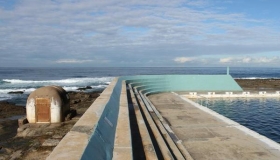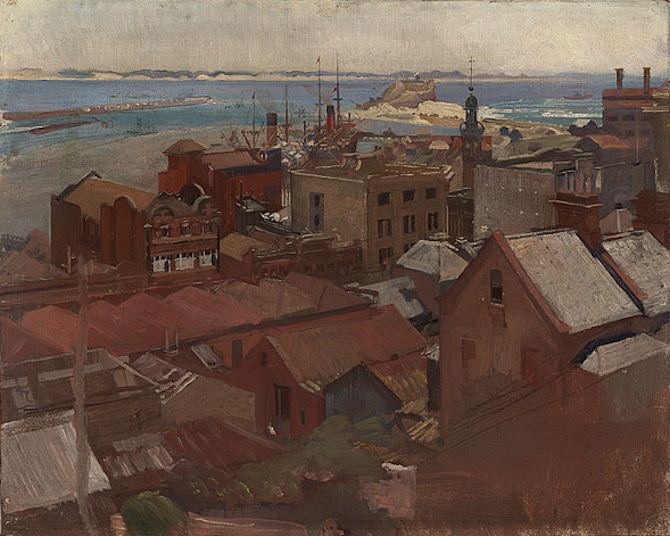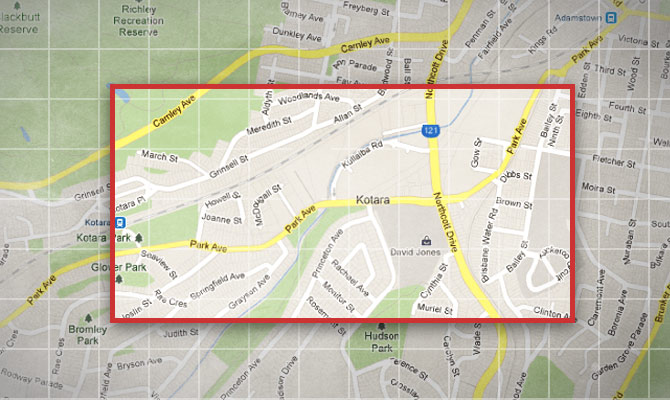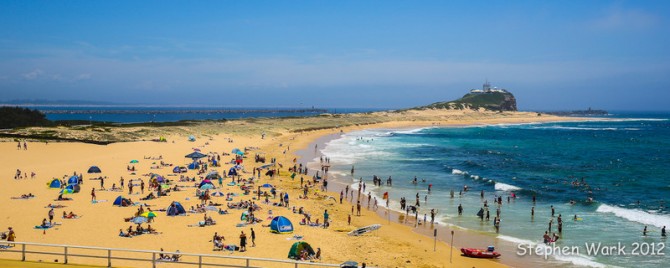
Reading the City: Literary Newcastle

George Lambert - Newcastle, 1925
Over the years, some of the Australia’s most well respected writers and artists have captured our city in times of elation and despair. Newcastle has a long history of nurturing such communities and Urban Insider Matt Endacott has picked out seven tangible links between our streetscapes and the creative process.
Coalopolis: High Victorian Newcastle (1850 - 1901) - Ibis Hotel
Mark Twain (1835 - 191), American author & humorist. With all due respect to the Ibis, this really isn’t the sort of place one expects to find a link with Mark Twain. After visiting the city in 1895, the author described Newcastle as “one long street, a graveyard at one end, and at the other, a gentleman’s club with no gentlemen in it”. The cemetery was probably that which existed in Honeysuckle at what is now 700 Hunter Street. Burials took place here between 1840 and about 1880, after which it was replaced by the existing graveyard at Sandgate. Although there would have still been headstones on the site when Twain was in town, most of the corpses were exhumed and moved to Sandgate by 1916.
Smokestacks & Gladstone bags: Steel City (1901 - 1939) - St John's Anglican Church
Harry Hooton (1908 - 1961), poet & social commentator. It was in Newcastle that the Australian poet Harry Hooton started his “serious writing”. Hooton was married at St. John’s Anglican Church in Cooks Hill on 3 November 1936 and his wife Thora bore their twins, Frank and Valerie, soon thereafter. Newcastle obviously inspired Hooton, so much so that he could barely find time for (paid) work. The poet moved about during his years in town, working as a door-to-door salesman and taking various labouring jobs. The Egg Board apparently broke his heart and the Hootons left Newcastle sometime during or after the Second World War.
Smokestacks & Gladstone bags: Steel City (1901 - 1939) - The Newcastle Club
George Washington Lambert (1873 - 1930), Australian artist. While in Newcastle painting the President of the Newcastle Club, George Lambert took the opportunity to capture our city during the Jazz Age. From the verandah of the Newcastle Club, Lambert painted the East End skyline as it appeared in 1925. The Customs House clock tower stands out, as does Nobby’s and the foreboding chimneys at Zaara Street (demolished). Chimneypots and rooftops compete for our attention in the foreground, as do the tangled wires that first brought electricity to the city centre. The stillness that Lambert captured was, however, temporary. By the late 1930s, the sharp lines of the Art Deco era had transformed the “Dickensian” skyline and the city was watching the Stockton Bight with trepidation. A war was on the way.
Brownouts & bomb craters: Newcastle at War (1939 - 1945) - Parnell Place
Dymphna Cusack (1902 - 1981), author. It appears that Dymphna Cusack couldn’t have picked a more dangerous place to be on the morning of June 8, 1942. As enemy shells starting bringing down powerlines and blowing out windows in the East End, Cusack found herself in the thick of it looking out of her kitchen window near Fort Scratchley. “When I poked my head out … with what I consider was pardonable curiosity, the sky was a blaze of light and the sea gleaming silver and blue,” wrote Miss Cusack after the dawn attack. “Then, whizz! With a high screaming whine that sounded like all the Empire Day rockets in the world rolled into one, something tore through the air above the house and lodged with a sickening crunch in the reserve some 50 yards away”. The shell in question, having been fired from a submarine submerged off Stockton Beach, damaged a row of townhouses between Scott and Alfred Streets. Although unbeknownst to Cusack, nine-year-old Peter Wilson, who had been plucked from under the covers seconds before the bomb destroyed his bedroom, had just narrowly escaped death across the street. A warden soon demanded that Cusack take cover in the Parnell Place air raid shelter, to which she made her way after “[running] round like a small, skinned rabbit looking for its coat”.
Brownouts & bomb craters: Newcastle at War (1939 - 1945) - Newcastle Junior Boys' High School
(Now Newcastle East Public School). James McAuley (1917 - 1976), poet, journalist & literary critic. In his poem “Self-portrait, Newcastle 1942”, old Steel City almost forced this Australian poet out of a third floor window (“What will he do with his life?/ Jump three storeys down in the rain?). McAuley found himself in wartime Newcastle, a city where grime will “show black in the lungs of the dead”. Across the harbour, the heavy industry at Carrington and Mayfield West “bleeds a long rubric of war” and McAuley endeavours to capture our city at a time when Novocastrians were marching in lockstep to the air-raid shelters. During his stint in Newcastle, McAuley worked at Newcastle Junior Boys’ High School (later Newcastle East Public School). If he enjoyed his time in Newcastle, it certainly didn’t show. Between brushing coal-dust off his notebook and startling the house with his screams, McAuley taught students in what he called “the dullest/ Intermediate class”. Poor guy.
Out in the 'Burbs: Post-War Newcastle (1945 - 1989) - The Obelisk
Margaret Olley (1923 - 2011), painter. An underground reservoir at The Obelisk apparently sent the late Margaret Olley running for cover while she was perched above the city painting a panorama of the East End last century. Olley had a “love affair” with our fine city and lived in The Hill during the 1960s and 70s. Inspired by the heavy industry and the city’s topography, Olley stuck around to capture post-war Newcastle and was generous enough to make a substantial donation to the Newcastle Art Gallery before her death last year. Reminiscing about her time in Newcastle on ABC Television, Olley said that she missed “all that smog and sort of humming in the night”, going as far as to say that it was the “heartbeat of Newcastle”. Should you feel like getting a bit of creativity out of your system, you might like to take your palette and canvas up to The Obelisk and follow in the footsteps of one of the nation’s greatest artists by capturing a very different East End (smoke was still pluming out of the Zaara Street Power Station while Olley lived in Newcastle).
The Big Shake Up: Post-Earthquake Newcastle (1989 - present) - King Edward Park
Les Murray (1938 -), poet. Dubbed as “one of the leading poets of his generation”, Les Murray captured us as we “break-danced on earthquake feet/ and tottered on crutches down every street”. His poem The Newcastle Rounds is a fine example of his knack for dramatizing general ideas. In it, Murray draws on everything from Nobby’s to Essington Lewis (the general manager of the B.H.P. during World War Two). Few poets have been as in sync with the rhythm of our city as Murray. His poetry brings the old “one-company town” and post-industrial Newcastle into such startling proximity that they feel almost coeval. Murray also set part of his “secret autobiography”, Fredy Neptune, in Newcastle. Freddy, his hero, lived in a house underneath Fort Scartchley and at the end of the story we find Fredy and his wife up the hill in King Edward Park telling each other stories. Like Olley and McAuley, Murray has also been inspired by Newcastle harbour and sends his protagonist swimming in it near Carrington at “the time of night when secrets that won’t let people live, or sleep, walk them about, muttering and hunching”.






Hi Matthew I really liked your reading of the city of Newcastle - map and texts. I am in my final year in the English Department at Sydney Uni and my topic is reading and writing the material and fictional city of Sydney through 4 novels. My supervisor is Peter Kirkpatrick. Anyway it would be great to have a chat sometime about our overlapping literary, urban and geographical interests. I am also in the process of ‘mapping’ my texts and the writers onto Google Sydney.
Susan King